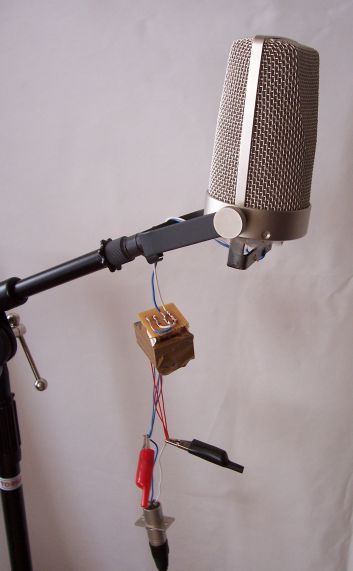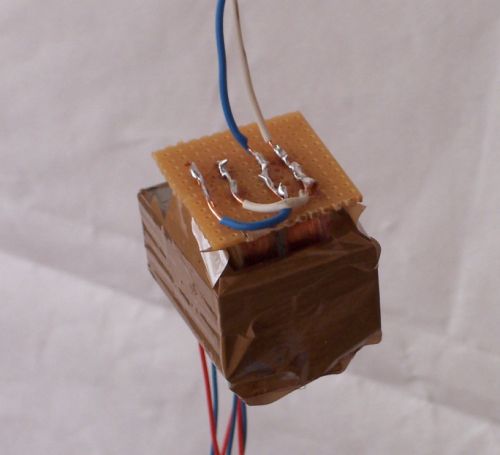Here's an update on my experiments re DIY ribbon transformer winding. (Thanks again CJ for the great tips)
For the time being I ditched the idea of re-winding the stock transformer in my cheapo ribbon mic. Instead I cracked an old 9V wallwart and took a look at the transformer inside. Just for laughs, I decided to just rearrange the parts the tranny is made of. This tranny consisted of E I lams, and two bobbins next to each other. One with thicker wire (.5mm) and one with finer wire (.1 mm I'd say). I unwound the wire and wound both bobbins more or less identically: 1 layer of the thick wire (8 turns I think) and many layers of thin wire, then another layer of the tick wire and more of the thin wire. pri-sec-pri-sec. I didn't have a counter on my improvised winding machine, so the secondaries were just played by ear. As it turned out I ran out of the thin wire too soon on the last secondary. DC of the secondaries, if I remember correctly was
1: 164 ohms
2: 126 ohms
3: 174 ohms
4: 51 ohms
To make up a bit for the unequal secondaries I wired 2 and 4 in series. This gives me three secondaries of about 170 ohms. The primaries are wired in parallel, DCR is very very low, about .1 ohms.
Wiring the three secondaries in parallel gives a pretty normal ribbon step up ratio. About 1:30 I'd guess. Wiring all secondaries in series gives a very high step up ratio for use with an active impedance converter.
Surprisingly, this crappily improvised tranny doen't sound bad. I made a comparative measurement and found that the treble is really good, acutally. Bass is a bit lower than on a commercial tranny, but not bad. It actually cuts just enough bass to make it sound good at "LD condenser distance"
Here's a sound clip I recorded standing about 20-25 cm in front of the mic:
As you can hear, there is a slight hum problem. My McGyver Tranny really likes to pick up hum from all sources, almost like a single coil guitar. Does anybody know a way to reduce this hum without using a MU-metal housing. I'm afraid the tranny is a bit too big to find a suitable can. Does the size of the tranny make it more susceptable to hum? Forgot to measure the tranny's size, but I'd guess about 5 x 5 x 6.5 cm. About 3 times larger than a normal ribbon tranny.
There's also some hiss, but it seems that some of it may disappear once the contacts to the ribbon become shorter and more solid.
Improvised mic:

McGyver Tranny:

For the time being I ditched the idea of re-winding the stock transformer in my cheapo ribbon mic. Instead I cracked an old 9V wallwart and took a look at the transformer inside. Just for laughs, I decided to just rearrange the parts the tranny is made of. This tranny consisted of E I lams, and two bobbins next to each other. One with thicker wire (.5mm) and one with finer wire (.1 mm I'd say). I unwound the wire and wound both bobbins more or less identically: 1 layer of the thick wire (8 turns I think) and many layers of thin wire, then another layer of the tick wire and more of the thin wire. pri-sec-pri-sec. I didn't have a counter on my improvised winding machine, so the secondaries were just played by ear. As it turned out I ran out of the thin wire too soon on the last secondary. DC of the secondaries, if I remember correctly was
1: 164 ohms
2: 126 ohms
3: 174 ohms
4: 51 ohms
To make up a bit for the unequal secondaries I wired 2 and 4 in series. This gives me three secondaries of about 170 ohms. The primaries are wired in parallel, DCR is very very low, about .1 ohms.
Wiring the three secondaries in parallel gives a pretty normal ribbon step up ratio. About 1:30 I'd guess. Wiring all secondaries in series gives a very high step up ratio for use with an active impedance converter.
Surprisingly, this crappily improvised tranny doen't sound bad. I made a comparative measurement and found that the treble is really good, acutally. Bass is a bit lower than on a commercial tranny, but not bad. It actually cuts just enough bass to make it sound good at "LD condenser distance"
Here's a sound clip I recorded standing about 20-25 cm in front of the mic:
As you can hear, there is a slight hum problem. My McGyver Tranny really likes to pick up hum from all sources, almost like a single coil guitar. Does anybody know a way to reduce this hum without using a MU-metal housing. I'm afraid the tranny is a bit too big to find a suitable can. Does the size of the tranny make it more susceptable to hum? Forgot to measure the tranny's size, but I'd guess about 5 x 5 x 6.5 cm. About 3 times larger than a normal ribbon tranny.
There's also some hiss, but it seems that some of it may disappear once the contacts to the ribbon become shorter and more solid.
Improvised mic:

McGyver Tranny:



